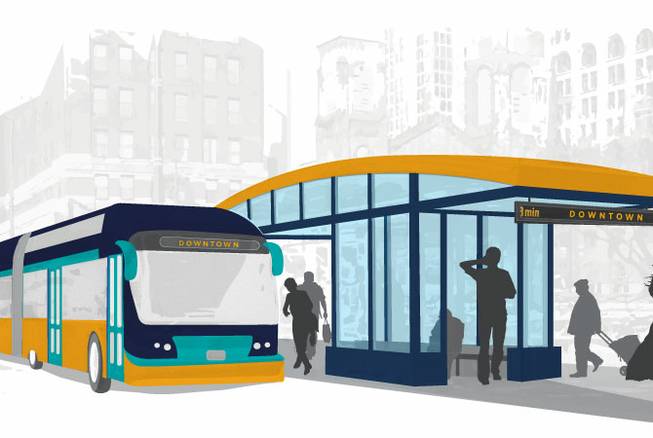
Thursday, March 15, 2018 | 2 a.m.
High-capacity transit—systems that carry a large number of people—is an important component of many major metropolitan areas. Along with other benefits associated with public transportation, high-capacity transit offers one solution to a problem that plagues many Las Vegans: traffic congestion.
In a study published by the National Bureau of Economic Research, researchers suggest that when public transit isn’t readily available, transit riders instead commute via congested roadways, leading to a 47 percent increase in traffic delays. This study, based on an analysis of data stemming from the 2003 transit worker strike in LA, found that congestion increased most considerably on freeways that run parallel to high-volume transit lines.
High-capacity transit can improve overall traffic conditions and may be particularly beneficial for providing a fast and reliable travel option on our city’s most heavily trafficked corridors. Besides improving traffic flow, high-capacity transit aims to offer commuters an option that is as quick and efficient as driving.
What is high-capacity transit?
Many cities, including Las Vegas, rely on a fixed transit system—vehicles such as buses that run along a route and on a set schedule. They tend to include multiple stops and are subject to the same traffic conditions car travelers face.
High-capacity transit is an optimized version of traditional public transportation and is characterized by the ability to carry a large volume of passengers. In many cases, it offers more frequent service, fewer stops and faster travel speeds. Most types of high-capacity transit do not share lanes with other vehicles on the road, which grants passengers a more efficient travel experience and frees up roadways. This amounts to decreased traffic congestion and an increase in overall mobility for residents and visitors.
For cities that still depend solely on fixed transit systems, high-capacity transit represents the next frontier in commuter travel. There are a few types of high-capacity transit systems.
The most common include:
• Light rail: Light rail systems are the modern incarnation of street cars. Operating along a rail line and often powered by an electrical system, these cars are given a dedicated lane. This results in exclusive right-of-way on the roads and makes for faster and more dependable travel times.
• Bus rapid transit: Bus rapid transit is similar to light rail, but operates with high-quality buses instead of trains. These buses also have exclusive right-of-way and travel in dedicated lanes, making them more reliable than the average bus service.
• Rapid bus: A variation on bus rapid transit systems, rapid buses do travel in normal traffic, but take advantage of things like the ability to signal for a green light when approaching an intersection. They also often use shorter, bus-only lanes to bypass cars backed up at traffic signals.
Light rail and bus rapid transit stations
Rather than typical bus stops, light rail and bus rapid transit generally provide amenities such as shelters, real-time transit arrival information and level boarding so passengers don’t have to step up in order to board. They’re often located in central, walkable areas.
Why is high-capacity transit important?
High-capacity transit benefits passengers of public transportation and contributes to the overall health and flow of cities.
The Texas Transportation Institute releases a regular study that evaluates and compares traffic congestion in urban areas across the country. TTI estimates that in 2014, the average automobile commuter in the Las Vegas/Henderson area experienced delays totaling 46 hours. This does not account for overall commuting time—it speaks simply to the extra time spent sitting in traffic. This means the average Las Vegas resident wastes almost two whole days a year because of traffic congestion.
While that amount of time is jarring on its own, TTI further reports that roadway congestion costs the average driver $984 and leads to 21 gallons of excess fuel consumption per vehicle.
To address this issue, a transportation project underway could put a high-capacity transit system along the Maryland Parkway corridor. Maryland Parkway is one of the most heavily trafficked road ways in the Valley and carries more than 9,000 transit riders and 33,000 cars each day, linking to 21 transit routes and high-activity locations such as McCarran International Airport, UNLV and Sunrise Hospital.
While the impact of this project is still being evaluated, many are hopeful it will be a large step toward reduced traffic congestion. This project is in development and part of a future transportation plan called OnBoard. It will identify new transit services, emerging technologies and other enhancements that can keep us moving.
